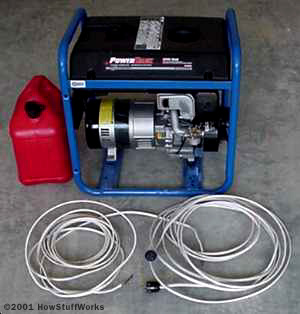An engine-powered
generator is an easy way to supply your house with emergency power. They are relatively inexpensive (typical price for a 5,000-watt generator ranges between $600 and $1,200), produce clean, 120- or 240-volt sine-wave power, and consume only about a gallon of gas every two hours or so (at 1,000-watt output). You can also purchase generators that run off of diesel fuel or propane.

A 5,000-watt gasoline-powered generator
This generator has a 10-horsepower engine and a 5,000-watt generator with a surge rating of 6,500 watts. The gas tank
(black, mounted across the top of the frame) holds 7 gallons and runs about 12 hours at 1,000-watt usage levels. This generator
produces 120-volt or 240-volt output. It is shown with its grounding cable and the 240-volt cable that plugs it into the house's circuit panel.
|
The disadvantages of engine-powered generators include:
- Fuel storage
- Noise (especially the less-expensive models)
- Engine maintenance
Fuel storage can be a nuisance -- gasoline cannot be stored for more than a month or so unless you use a fuel stabilizing chemical, and even then the shelf-life is relatively short. You need to rotate your inventory on a regular basis to avoid problems.
Here at the Brain household we have a 5,000-watt generator. We are able to run just about everything in the house -- including the well pump, water heater and refrigerator -- with the generator. The only thing we cannot run is the heat pump, so we have gas logs as a backup heat source. We do stagger our usage, but that is not a big problem for us. For example, we will run the refrigerator for an hour and then turn it off to run the well pump.
An inverter is an electrical device that converts 12-volt power into 120-volt power. Typically you run an inverter off of your car's battery or off of a deep-cycle battery that you buy specifically to power the inverter. An inverter is a very easy and inexpensive solution if you can keep your power demands in the 200-watt range. If you are willing to build a more elaborate system, inverters can be a good option up to about 2,500 watts, although they tend to get expensive at that point (a 2,500-watt inverter might cost $600 to $1,000, and then you need to buy a number of deep-cycle batteries and a charging system). Inverters have two main advantages:
- They are silent
- They are maintenance-free (when you operate them from your car's battery -- if you build your own deep-cycle battery bank you will have to maintain the batteries).
Here are some things to think about when considering an inverter:
- You can buy a small 150- or 300-watt quasi-sine-wave inverter for about $50 and plug it into your car's lighter socket. It can operate several light bulbs, a radio, a small TV, etc.
- A car's battery has a reserve capacity rating. A typical rating is 80 minutes, which means the battery can supply 25 amps at 12 volts for 80 minutes. If you consume 120 watts continuously, that means that you are draining about 10 amps from your car's battery continuously. A typical car battery can supply power at that level for perhaps three hours. A deep-cycle battery can supply power at that level for six or eight hours. Then you will need to recharge the battery (which takes awhile). However, if you are running two compact fluorescent bulbs at 15 watts each, total consumption is only 30 watts, or 2.5 amps at 12 volts. A car battery can supply power for about 12 hours at that level. A deep-cycle battery can supply power for a day or two at that level.
- A typical car's alternator can supply only about 700 watts maximum. To run an inverter with a capacity greater than 300 watts from a car, you need to connect it directly to the car's battery with cables, and you will need to run the car's engine continuously. At that point, it would be much more efficient to buy a gasoline generator.
From this discussion you can see that an inverter only makes sense for very small power loads over relatively short time frames. You can build a large and elaborate battery system to run your inverter if you choose, but that can get expensive.
(Note that a large battery bank connected to an inverter is an important part of most home-scale solar power systems. Solar panels are used to recharge the batteries in that case. See How Solar Cells Work for details.)
Here at the Brain household we have a 140-watt inverter. We run the generator during the day. At night we use the inverter hooked to the car to power one or two compact fluorescent bulbs that provide light in the house.

